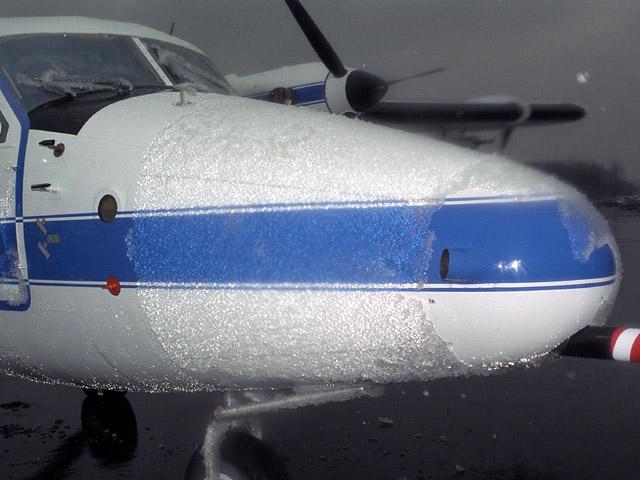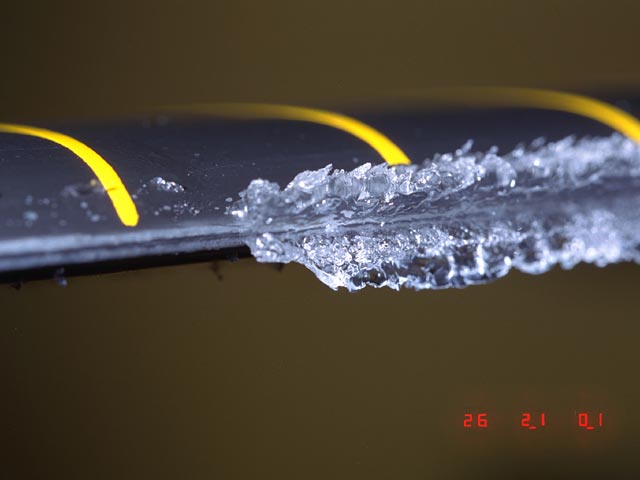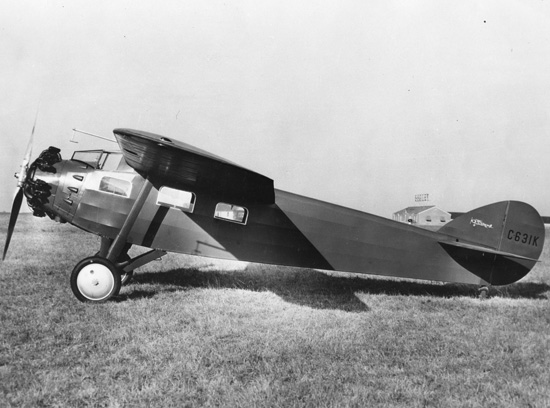|
ThermaWing
The ThermaWing ice protection system uses a flexible, electrically conductive, graphite foil attached to a wing's leading edge. Once activated the foil heats quickly, melting and then shedding any ice. Background In 1998 NASA Glenn initiated the research and development of the Thermawing system for general aviation. Supported by the NASA SBIR (Small Business Innovative Research) program Kelly Aerospace Thermal Systems put the system into production. The FAA has certified the heater element configuration. The original launch of the system was on Columbia Aircraft Manufacturing (now Cessna) 350 and 400 airframes. ThermaWing (formerly EVADE) employs 6 heaters, 3 heater control modules, one main electronic controller and one 7500 watt alternator. Operation The outer layer of the laminate is made of heat-conducting polyvinyl chloride. It offers the durability of a fluoropolymer. A zoned heater system is controlled by a solid-state processor. The leading edge (the "impingement" ... [...More Info...] [...Related Items...] OR: [Wikipedia] [Google] [Baidu] |
Ice Protection System
In aeronautics, ice protection systems keep atmospheric moisture from accumulating on aircraft surfaces, such as wings, propellers, rotor blades, engine intakes, and environmental control intakes. Ice buildup can change the shape of airfoils and flight control surfaces, degrading control and handling characteristics as well as performance. An anti-icing, de-icing, or ice protection system either prevents formation of ice, or enables the aircraft to shed the ice before it becomes dangerous. Effects of icing Aircraft icing increases weight and drag, decreases lift, and can decrease thrust. Ice reduces engine power by blocking air intakes. When ice builds up by freezing upon impact or freezing as runoff, it changes the aerodynamics of the surface by modifying the shape and the smoothness of the surface which increases drag, and decreases wing lift or propeller thrust. Both a decrease in lift on the wing due to an altered airfoil shape, and the increase in weight from the ice loa ... [...More Info...] [...Related Items...] OR: [Wikipedia] [Google] [Baidu] |
Ice Protection
In aeronautics, ice protection systems keep atmospheric moisture from accumulating on aircraft surfaces, such as wings, Propeller (aeronautics), propellers, Helicopter rotor, rotor blades, Intake, engine intakes, and Environmental control system, environmental control intakes. Ice buildup can change the shape of airfoils and flight control surfaces, degrading control and handling characteristics as well as performance. An anti-icing, de-icing, or ice protection system either prevents Atmospheric icing, formation of ice, or enables the aircraft to shed the ice before it becomes dangerous. Effects of icing Aircraft icing increases weight and drag, decreases lift, and can decrease thrust. Ice reduces engine power by blocking air intakes. When ice builds up by freezing upon impact or freezing as runoff, it changes the aerodynamics of the surface by modifying the shape and the smoothness of the surface which increases drag, and decreases wing lift or propeller thrust. Both a decrease ... [...More Info...] [...Related Items...] OR: [Wikipedia] [Google] [Baidu] |
Leading Edge
The leading edge of an airfoil surface such as a wing is its foremost edge and is therefore the part which first meets the oncoming air.Crane, Dale: ''Dictionary of Aeronautical Terms, third edition'', page 305. Aviation Supplies & Academics, 1997. Characteristics Sweep Seen in plan the leading edge may be straight, curved, kinked or a combination of these. A straight leading edge may be swept or unswept, while curves or kinks always mean that part of the leading edge is swept. On a swept wing the sweep angle may differ from that of the wing, as wing sweep is conventionally measured at the airfoil 25% chord line. However on a delta wing the leading edge sweep defines the wing sweep. Radius and stagnation point A rounded leading edge helps to maintain a smooth airflow at varying angles of incidence to the airflow. Most subsonic airfoils therefore have a rounded leading edge. The degree of rounding is characterised by the profile radius at that point. The airflow divides to ... [...More Info...] [...Related Items...] OR: [Wikipedia] [Google] [Baidu] |
NASA Glenn
NASA John H. Glenn Research Center at Lewis Field is a NASA center within the cities of Brook Park and Cleveland between Cleveland Hopkins International Airport and the Rocky River Reservation of Cleveland Metroparks, with a subsidiary facility in Sandusky, Ohio. Its acting director is James A. Kenyon. Glenn Research Center is one of ten major NASA facilities, whose primary mission is to develop science and technology for use in aeronautics and space. , it employed about 1,650 civil servants and 1,850 support contractors on or near its site. In 2010, the formerly on-site NASA Visitors Center moved to the Great Lakes Science Center in the North Coast Harbor area of downtown Cleveland. History The installation was established in 1942 as part of the National Advisory Committee for Aeronautics (NACA) and was later incorporated into the National Aeronautics and Space Administration as a laboratory for aircraft engine research. It was first named the Aircraft Engine Research Labor ... [...More Info...] [...Related Items...] OR: [Wikipedia] [Google] [Baidu] |
General Aviation
General aviation (GA) is defined by the International Civil Aviation Organization (ICAO) as all civil aviation aircraft operations with the exception of commercial air transport or aerial work, which is defined as specialized aviation services for other purposes. However, for statistical purposes ICAO uses a definition of general aviation which includes aerial work. General aviation thus represents the "private transport" and recreational components of aviation. Definition The International Civil Aviation Organization (ICAO) defines civil aviation aircraft operations in three categories: General Aviation (GA), Aerial Work (AW) and Commercial Air Transport (CAT). Aerial work operations are separated from general aviation by ICAO by this definition. Aerial work is when an aircraft is used for specialized services such as agriculture, construction, photography, surveying, observation and patrol, search and rescue, and aerial advertisement. However, for statistical purposes ... [...More Info...] [...Related Items...] OR: [Wikipedia] [Google] [Baidu] |
NASA
The National Aeronautics and Space Administration (NASA ) is an independent agency of the US federal government responsible for the civil space program, aeronautics research, and space research. NASA was established in 1958, succeeding the National Advisory Committee for Aeronautics (NACA), to give the U.S. space development effort a distinctly civilian orientation, emphasizing peaceful applications in space science. NASA has since led most American space exploration, including Project Mercury, Project Gemini, the 1968-1972 Apollo Moon landing missions, the Skylab space station, and the Space Shuttle. NASA supports the International Space Station and oversees the development of the Orion spacecraft and the Space Launch System for the crewed lunar Artemis program, Commercial Crew spacecraft, and the planned Lunar Gateway space station. The agency is also responsible for the Launch Services Program, which provides oversight of launch operations and countdown management f ... [...More Info...] [...Related Items...] OR: [Wikipedia] [Google] [Baidu] |
Small Business Innovative Research
The Small Business Innovation Research (or SBIR) program is a U.S. government funding program, coordinated by the Small Business Administration, intended to help certain small businesses conduct research and development (R&D). Funding takes the form of contracts or grants. The recipient projects must have the potential for commercialization and must meet specific U.S. government R&D needs. Funds are obtained by allocating a certain percentage of the total extramural (R&D) budgets of the 11 federal agencies with extramural research budgets in excess of $100 million. Approximately $2.5 billion is awarded through this program each year. The United States Department of Defense (DoD) is the largest agency in this program with approximately $1 billion in SBIR grants annually. Over half the awards from the DoD are to firms with fewer than 25 people and a third to firms of fewer than 10. A fifth are minority or women-owned businesses. Historically a quarter of the companies receiving gra ... [...More Info...] [...Related Items...] OR: [Wikipedia] [Google] [Baidu] |
Cessna
Cessna () is an American brand of general aviation aircraft owned by Textron Aviation since 2014, headquartered in Wichita, Kansas. Originally, it was a brand of the Cessna Aircraft Company, an American general aviation aircraft manufacturing corporation also headquartered in Wichita. The company produced small, piston-powered aircraft, as well as business jets. For much of the mid-to-late 20th century, Cessna was one of the highest-volume and most diverse producers of general aviation aircraft in the world. It was founded in 1927 by Clyde Cessna and Victor Roos and was purchased by General Dynamics in 1985, then by Textron, Inc. in 1992. In March 2014, when Textron purchased the Beechcraft and Hawker Aircraft corporations, Cessna ceased operations as a subsidiary company and joined the others as one of the three distinct brands produced by Textron Aviation. Throughout its history, and especially in the years following World War II, Cessna became best-known for producing hig ... [...More Info...] [...Related Items...] OR: [Wikipedia] [Google] [Baidu] |
Fluoropolymer
A fluoropolymer is a fluorocarbon-based polymer with multiple carbon–fluorine bonds. It is characterized by a high resistance to solvents, acids, and bases. The best known fluoropolymer is polytetrafluoroethylene under the brand name "Teflon," trademarked by the DuPont Company. History In 1938, polytetrafluoroethylene (DuPont brand name Teflon) was discovered by accident by a recently hired DuPont Ph.D., Roy J. Plunkett. While working with tetrafluoroethylene gas to develop refrigerants, he noticed that a previously pressurized cylinder had no pressure remaining. In dissecting the cylinder, he found a mass of white solid in a quantity similar to that of the tetrafluoroethylene gas. It was determined that this material was a new-to-the-world polymer. Tests showed the substance was resistant to corrosion from most acids, bases and solvents and had better high temperature stability than any other plastic. By early 1941, a crash program was making substantial quantities of P ... [...More Info...] [...Related Items...] OR: [Wikipedia] [Google] [Baidu] |
Aerodynamic
Aerodynamics, from grc, ἀήρ ''aero'' (air) + grc, δυναμική (dynamics), is the study of the motion of air, particularly when affected by a solid object, such as an airplane wing. It involves topics covered in the field of fluid dynamics and its subfield of gas dynamics. The term ''aerodynamics'' is often used synonymously with gas dynamics, the difference being that "gas dynamics" applies to the study of the motion of all gases, and is not limited to air. The formal study of aerodynamics began in the modern sense in the eighteenth century, although observations of fundamental concepts such as aerodynamic drag were recorded much earlier. Most of the early efforts in aerodynamics were directed toward achieving heavier-than-air flight, which was first demonstrated by Otto Lilienthal in 1891. Since then, the use of aerodynamics through mathematical analysis, empirical approximations, wind tunnel experimentation, and computer simulations has formed a rational basis for ... [...More Info...] [...Related Items...] OR: [Wikipedia] [Google] [Baidu] |
Icing Conditions
In aviation, icing conditions are atmospheric conditions that can lead to the formation of water ice on an aircraft. Ice accretion and accumulation can affect the external surfaces of an aircraft – in which case it is referred to as ''airframe icing'' – or the engine, resulting in carburetor icing, air inlet icing or more generically ''engine icing''. These phenomena may possibly but do not necessarily occur together. Both airframe and engine icing have resulted in numerous fatal accidents in aviation history. Not all aircraft, especially general aviation aircraft, are certified for ''flight into known icing'' (FIKI) – that is flying into areas with icing conditions certain or likely to exist, based on pilot reports, observations, and forecasts. In order to be FIKI-certified, aircraft must be fitted with suitable ice protection systems to prevent accidents by icing. Definition Icing conditions exist when the air contains droplets of supercooled liquid water. They freeze ... [...More Info...] [...Related Items...] OR: [Wikipedia] [Google] [Baidu] |



.jpg)

.jpg)